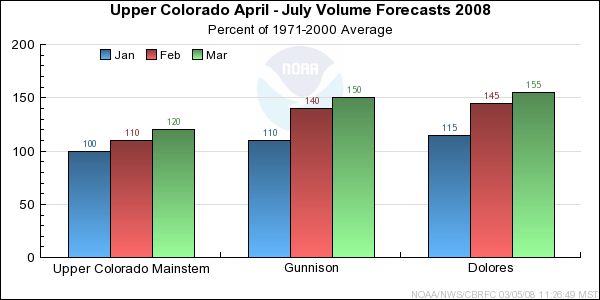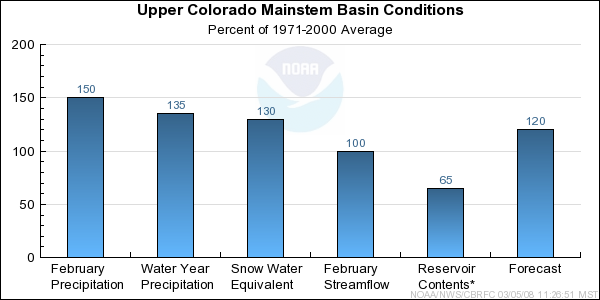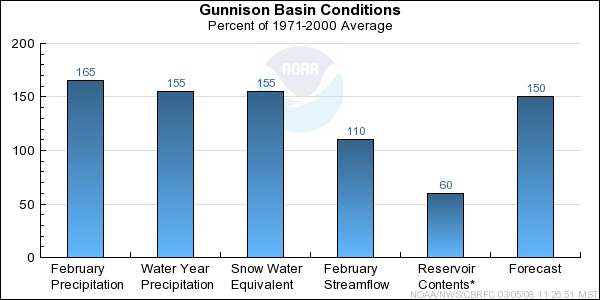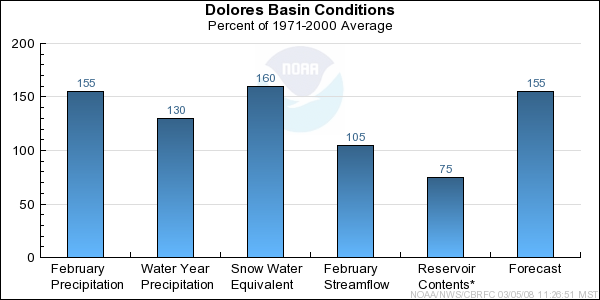Upper Colorado Water Supply Outlook, March 1, 2008
Note: This publication is scheduled for revision. If you have feedback on content, format, or publication frequency, please contact us.
Contents
Upper Colorado Summary
February was yet another month of above average precipitation across the Upper
Colorado Basin. This increased the snow water equivalent 5% to 10% from
February 1st to March 1st in the Dolores, Gunnison, and Upper Colorado
mainstem basins. As a result, median forecasts in each basin rose 10% for the
April through July runoff period.

*Median of forecasts within each basin.
Upper Colorado Mainstem Basin Conditions
The percent of snow water equivalent in the Upper Colorado mainstem basin
increased 10% from February 1st to March 1st due to yet another month of much
above average precipitation. February precipitation was 150% of average, which
brought the seasonal total to 135% and snow water equivalent to 130% of average.
The snow remains highest in the Roaring Fork basin with over 150% of average.
Model soil moisture is near to just below average at this time and streamflow
was near average during February. Due to the increases in snow water
equivalent all forecasts increased from last month. The April through July
streamflow forecasts now range between 100% and 140% of average.

* Percent usable capacity, not percent average contents.
Click for multi-month Graph.
Gunnison Basin Conditions
In February, the Gunnison Basin once again received above average monthly precipitation at 165% of average. All SNOTEL gages in the basin, except Mesa Lakes and Park Reservoir, are now above their average seasonal maximum snowpack accumulation. The snowpack accumulation season on average continues into the beginning of April. In addition, the current percent of average snow water equivalent in the basin increased by 10% since February 1st.
Streamflow for February remained slightly above average at 110%. Modeled soil moisture conditions in the Gunnison basin are slightly below average, except in the headwater areas of the Uncompaghre were modeled soil moisture is slightly above average. With another month of above average precipitation, the April through July volume forecasts have increased slightly or stayed the same as last month. Volume forecasts now range from 135% of average at Taylor Park Reservoir to 162% of average at Paonia Reservoir.

* Percent usable capacity, not percent average contents.
Click for multi-month Graph.
Dolores Basin Conditions
Monthly precipitation was once again above average in the Dolores Basin at 155% of average. The current March 1st percent of average snow water equivalent in the basin increased by 5% since February 1st. Also, all the SNOTEL gages located in the headwater area of the Dolores Basin are now over 110% of average seasonal maximum snowpack accumulation. The snowpack accumulation season on average continues into the beginning of April.
Streamflow in the Dolores Basin for February was just above average at 105%. Modeled soil moisture conditions are around average for the Dolores Basin. With the above average precipitation in February, the April through July volume forecasts in the Dolores Basin have been increased. The forecast at McPhee Reservoir is now at 500 kaf, this is 156% of average. The highest April through July runoff volume on record at McPhee reservoir is 524 kaf.

* Percent usable capacity, not percent average contents.
Click for multi-month Graph.
Differences between the full period forecasts and the residual forecasts may not exactly equal the actual observed volumes due to rounding conventions (see Definitions section).
Precipitation Maps


Hydrologist: Brenda Alcorn, John Lhotak







